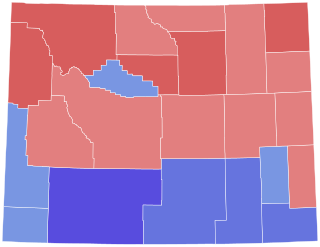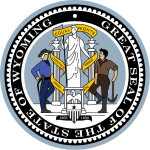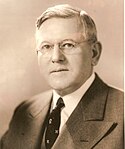
The 1930 United States Senate election in Wyoming was held on November 4, 1930. Following the death of Republican Senator Francis E. Warren, former Casper Mayor Patrick J. Sullivan was appointed to replace him. Sullivan did not seek re-election, however. Following a contested Republican primary, former Governor Robert D. Carey emerged as the nominee, and faced Democrat Harry Schwartz, an attorney from Casper and a local school board member, in the general election. Despite the strong performance by Democrats nationwide in 1930, Carey defeated Schwartz by a wide margin.

The 1936 United States Senate election in Wyoming was held on November 3, 1936. First-term Republican Senator Robert D. Carey ran for re-election. In a rematch of the 1930 race, he once again faced Harry Schwartz, who had since been elected to the State Senate. Carey's fortunes turned considerably from six years prior; he lost re-election to Schwartz by a decisive margin as President Franklin D. Roosevelt defeated Republican presidential nominee Alf Landon in Wyoming in a landslide.

The 1940 United States Senate election in Wyoming took place on November 5, 1940. Democratic Senator Joseph C. O'Mahoney ran for re-election to a second full term. He faced Republican Milward Simpson, a member of the University of Wyoming Board of Trustees and a former State Representative, in the general election. Though the presidential election in Wyoming was relatively close, O'Mahoney outperformed President Franklin D. Roosevelt's narrow win, and defeated Simpson in a landslide to win his second term.

The 1946 United States Senate election in Wyoming took place on November 5, 1946. Democratic Senator Joseph C. O'Mahoney ran for re-election to a third term. In the general election, he faced Republican Harry B. Henderson, the former Chairman of the Republican Party of Wyoming and a former State Senator. Despite the strong performance of the Republican Party nationally, O'Mahoney's popularity was strong enough for him to win re-election yet again by a wide margin, though slightly narrower than his 1940 re-election.

The 1972 United States Senate election in Wyoming was held on November 7, 1972. Incumbent Republican Senator Clifford Hansen ran for re-election to a second term. He was challenged by Democratic nominee Mike Vinich, a former aide to Congressman Teno Roncalio and a bar owner in Hudson. As Hansen ran for re-election, President Richard Nixon was overwhelmingly defeating Democratic presidential nominee George McGovern in Wyoming. Hansen managed to outperform even Nixon, winning his second term in a landslide over Vinich.

The 1978 United States Senate election in Wyoming was held on November 7, 1978. Incumbent Republican Senator Clifford Hansen declined to seek a third term in office. Former State Representative Alan K. Simpson, the son of former Senator Milward Simpson, won a contested Republican primary and faced Raymond B. Whitaker, the 1960 Democratic nominee for the Senate, in the general election. Despite a favorable environment for Republicans nationwide, Simpson's performance decreased considerably from Hansen's 1972 landslide. Nonetheless, he easily defeated Whitaker, winning 62% of the vote to Whitaker's 38%.

The 1934 United States Senate elections in Wyoming took place on November 6, 1934. Incumbent Democratic Senator John B. Kendrick died on November 3, 1933, and Joseph C. O'Mahoney was appointed by Governor Leslie A. Miller as Kendrick's replacement. Two elections for the same Senate seat were held on the same day; one as a special election to fill the remainder of Kendrick's original six-year term, and another to select a Senator to serve the next six-year term. O'Mahoney ran for re-election in both elections. He was opposed by Republican Congressman Vincent Carter. Aided by the strong performance by the Democratic Party throughout the country in 1934, and by Governor Miller's landslide re-election, O'Mahoney handily defeated Carter to win re-election.

The 1954 United States Senate elections in Wyoming took place on November 2, 1954. Incumbent Democratic Senator Lester C. Hunt, who decided not to be a candidate for re-election, committed suicide by firearm on June 19, 1954, and Republican Governor Clifford J. Rogers appointed former state highway commissioner Edward D. Crippa to replace him. Two elections for the Senate seat were held on the same day; one as a special election to fill the remainder of Hunt's original six-year term, and another to select a Senator to serve the next six-year term. Senator Crippa did not run for re-election.

A general election was held in the U.S. state of Wyoming on Tuesday, November 2, 1926. All of the state's executive officers—the Governor, Secretary of State, Auditor, Treasurer, and Superintendent of Public Instruction—were up for election. Republicans narrowly picked up the governorship and solidified their control on the other statewide offices, increasing their margin of victory in each race.

A general election was held in the U.S. state of Wyoming on Tuesday, November 4, 1930. All of the state's executive officers—the Governor, Secretary of State, Auditor, Treasurer, and Superintendent of Public Instruction—were up for election. Republicans narrowly held onto the Governor's office and won every other state office.

A general election was held in the U.S. state of Wyoming on Tuesday, November 6, 1934. All of the state's executive officers—the Governor, Secretary of State, Auditor, Treasurer, and Superintendent of Public Instruction—were up for election. In the 1932 gubernatorial special election, the Democratic candidate, Leslie A. Miller, won and ran for re-election for a full term in 1934. The Democratic Party also won elections for Secretary of State, Auditor, Treasurer, and Superintendent of Public Instruction, flipping those offices from the Republican Party.

A general election was held in the U.S. state of Wyoming on Tuesday, November 3, 1942. All of the state's executive officers—the governor, secretary of state, auditor, treasurer, and superintendent of public instruction—were up for election. Like the 1938 elections, this year's elections were something of a mixed bag for both parties. Democratic secretary of state Lester C. Hunt successfully defeated Republican governor Nels H. Smith for re-election, but Republicans flipped the secretary of state's office in Hunt's absence. The other incumbents—State Auditor William M. Jack, a Democrat, and Superintendent Esther L. Anderson, a Republican—were re-elected, and Republicans held onto the state treasurer's office.

A general election was held in the U.S. state of Wyoming on Tuesday, November 5, 1946. All of the state's executive officers—the governor, secretary of state, auditor, treasurer, and superintendent of public instruction—were up for election. The election was largely a rout for the Republican Party. Though Democratic governor Lester C. Hunt was narrowly re-elected, Democrats lost their two other state offices: auditor and secretary of State. Moreover, they were unable to win back any other state offices.

A general election was held in the U.S. state of Wyoming on Tuesday, November 7, 1950. All of the state's executive officers—the governor, secretary of state, auditor, treasurer, and superintendent of public instruction—were up for election. The Republican Party swept all of the offices. Following Democratic governor Lester C. Hunt's election to the U.S. Senate in 1948, Republican secretary of state Arthur G. Crane had been acting as governor. Republican Congressman Frank A. Barrett was elected governor, and Republican candidates won the other statewide races.

A general election was held in the U.S. state of Wyoming on Tuesday, November 2, 1954. All of the state's executive officers—the governor, secretary of state, auditor, treasurer, and superintendent of public instruction—were up for election. The result was largely a continuation of Republican rule, though Democrat Velma Linford won the election for Superintendent and the margins in most of the other races shrunk considerably from 1950.

A general election was held in the U.S. state of Wyoming on Tuesday, November 7, 1962. All of the state's executive officers—the Governor, Secretary of State, Auditor, Treasurer, and Superintendent of Public Instruction—were up for election. Republicans ran the table on the state's executive offices, defeating incumbent Governor Jack R. Gage and incumbent Superintendent Velma Linford and picking up the Secretary of State's office. Republican State Auditor Minnie A. Mitchell was re-elected and Republicans also held the Treasurer's office.

A general election was held in the U.S. state of Wyoming on Tuesday, November 8, 1966. All of the state's executive officers—the Governor, Secretary of State, Auditor, Treasurer, and Superintendent of Public Instruction—were up for election. After winning all of the statewide executive offices in 1962, Republicans did even better in 1966, improving their margins of victory in each race and holding all the offices.

A general election was held in the U.S. state of Wyoming on Tuesday, November 3, 1970. All of the state's executive officers—the Governor, Secretary of State, Auditor, Treasurer, and Superintendent of Public Instruction—were up for election. Continuing their success from 1962 and 1966, Republicans won all of the statewide executive offices once again, and all of them by large margins.

A general election was held in the U.S. state of Wyoming on Tuesday, November 7, 1922. All of the state's executive officers—the Governor, Secretary of State, Auditor, Treasurer, and Superintendent of Public Instruction—were up for election. Democrats improved considerably from their performances in 1918, with William B. Ross winning the gubernatorial election and almost all of their statewide candidates outpacing their 1918 nominees. However, Republicans held all of the other statewide offices.

A general election was held in the U.S. state of Wyoming on Tuesday, November 5, 1918. All of the state's executive officers—the Governor, Secretary of State, Auditor, Treasurer, and Superintendent of Public Instruction—were up for election. Republicans won all statewide offices by wide margins, and with Robert D. Carey's defeat of Frank L. Houx, picked up the governorship following two consecutive losses to Democrats.








